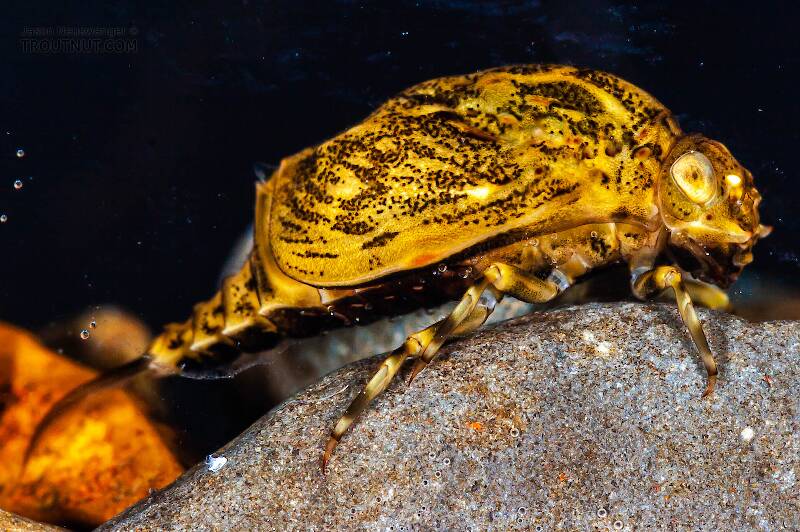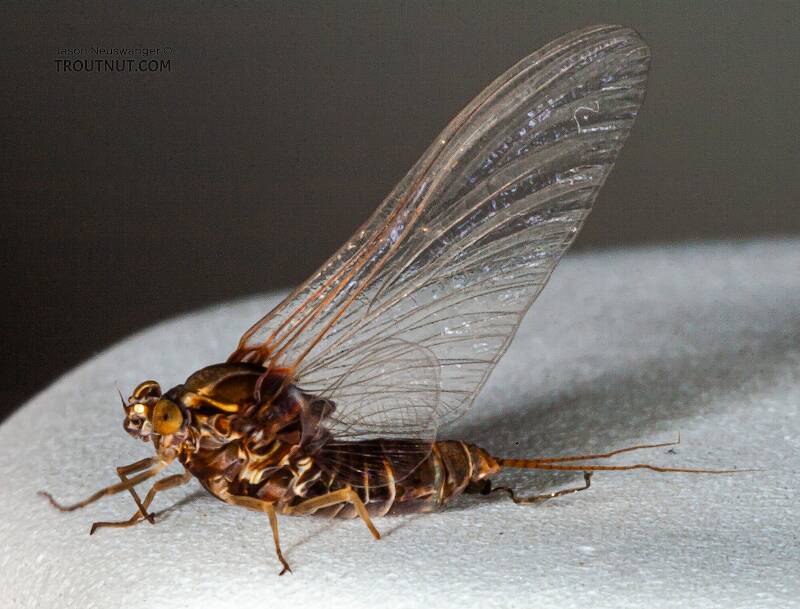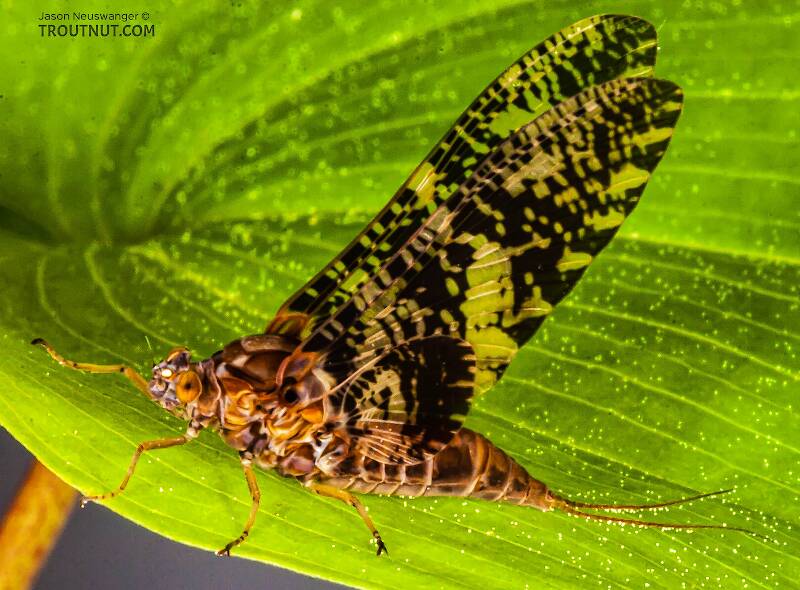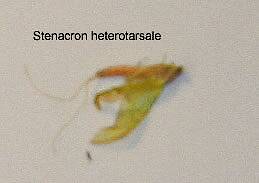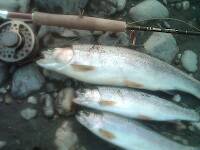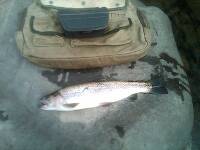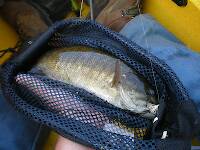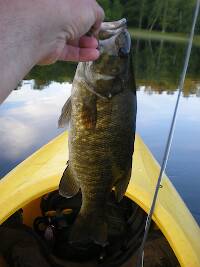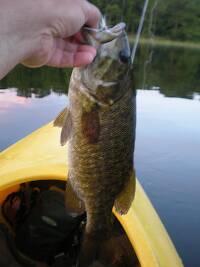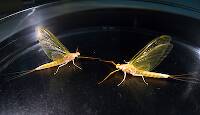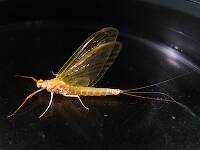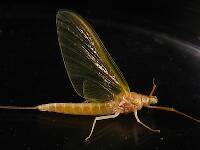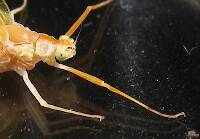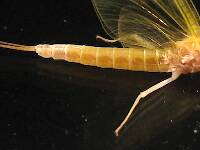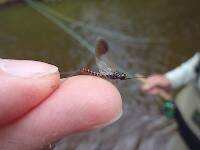
Salmonflies
Pteronarcys californica
The giant Salmonflies of the Western mountains are legendary for their proclivity to elicit consistent dry-fly action and ferocious strikes.
Featured on the forum

Nymphs of this species were fairly common in late-winter kick net samples from the upper Yakima River. Although I could not find a key to species of Zapada nymphs, a revision of the Nemouridae family by Baumann (1975) includes the following helpful sentence: "2 cervical gills on each side of midline, 1 arising inside and 1 outside of lateral cervical sclerites, usually single and elongate, sometimes constricted but with 3 or 4 branches arising beyond gill base in Zapada cinctipes." This specimen clearly has the branches and is within the range of that species.

Troutnut is a project started in 2003 by salmonid ecologist Jason "Troutnut" Neuswanger to help anglers and
fly tyers unabashedly embrace the entomological side of the sport. Learn more about Troutnut or
support the project for an enhanced experience here.
This topic is about the Mayfly Family Baetiscidae
The mayflies of this family are known mostly for their curious shapes, but they can create excellent spinner falls, too. Read about Baetisca, the only genus in this family, for details.Example specimens
Tnoetzel on Jan 14, 2009January 14th, 2009, 11:44 am EST
are these flies the flies we call batflies? They look like a size 12 may fly on the water but have a very stubby abreviated and robust body. They are becoming more and more a factor where I fish on the Au Sable River. Do these spinners retract thier tail section into the thorax?
Taxon on Jan 14, 2009January 14th, 2009, 5:15 pm EST
Tom-
Can't say that I've ever before heard of them being referred to by a common name of Batflies. However, I suppose the the black wing color in combination with the scalloped trailing edge of their forewings do "slightly" resemble the wings of a bat.
Can't say that I've ever before heard of them being referred to by a common name of Batflies. However, I suppose the the black wing color in combination with the scalloped trailing edge of their forewings do "slightly" resemble the wings of a bat.
Troutnut on Jan 14, 2009January 14th, 2009, 7:26 pm EST
These are surely your batflies. I haven't seen that name before, but I'll add it to the common names for Baetisca on this site because it's a good one. They fit the description perfectly, and nothing else does.
Their tails aren't retracted into the thorax or abdomen. They just have an unusual shape.
It's very interesting to see that they're a factor on the Au Sable, too. It wouldn't surprise me, given their importance on the Brule, which is a similar system.
What do you know about fishing this hatch? I'd love to hear some stories of Michigan batflies.
Their tails aren't retracted into the thorax or abdomen. They just have an unusual shape.
It's very interesting to see that they're a factor on the Au Sable, too. It wouldn't surprise me, given their importance on the Brule, which is a similar system.
What do you know about fishing this hatch? I'd love to hear some stories of Michigan batflies.
Jason Neuswanger, Ph.D.
Troutnut and salmonid ecologist
Troutnut and salmonid ecologist
Shawnny3 on Jan 15, 2009January 15th, 2009, 12:09 am EST
Bat is also a nice contraction of Baetisca. I suppose one could argue that it should be Baet, but that might lead to more posts about Latin pronunciations, and nobody needs that...
Lee Wulff eschewed the dainty bodies typical of the dry flies of his day and tied his Wulff patterns with really prominent bodies. He claimed that fish seemed to like the meatier profile, and it goes well proportionally with the general bushiness of the Wulff patterns. I wonder if this is a reason fish like the Baetisca hatches - lots of protein per inch.
-Shawn
Lee Wulff eschewed the dainty bodies typical of the dry flies of his day and tied his Wulff patterns with really prominent bodies. He claimed that fish seemed to like the meatier profile, and it goes well proportionally with the general bushiness of the Wulff patterns. I wonder if this is a reason fish like the Baetisca hatches - lots of protein per inch.
-Shawn
Jewelry-Quality Artistic Salmon Flies, by Shawn Davis
www.davisflydesigns.com
www.davisflydesigns.com
Taxon on Jan 27, 2009January 27th, 2009, 12:48 pm EST
Shawn-
Surely you jest. We all need it. It's just that no two "experts" seem to agree.
I suppose one could argue that it should be Baet, but that might lead to more posts about Latin pronunciations, and nobody needs that...
Surely you jest. We all need it. It's just that no two "experts" seem to agree.
Falsifly on Jan 28, 2009January 28th, 2009, 1:26 am EST
Taxon-
Louis-
Gonzo-
You’ve got to love that exchange
Mutillidae: moo-TILL-li-dee
Louis-
You say caley-BEE-tis; I say caley-BAY-tis.
You say moo-TILL-li-dee; I say moo-TILL-li-day.
caley-BEE-tis; caley-BAY-tis,
moo-TILL-li-dee; moo-TILL-li-day.
Let's call the whole thing off.
Gonzo-
I do not know which way to say
moo-TILL-li-dee, moo-TILL-li-day.
But I will bet (for all who care)
that interest in this small affair
is idle fun and baited snare.
The fish we seek don't care a whit.
It will not change their minds one bit.
With all these words, we prove once more
what's in a name is naught for sure--
it's just a way of keeping score!
You’ve got to love that exchange
Falsifly
When asked what I just caught that monster on I showed him. He put on his magnifiers and said, "I can't believe they can see that."
When asked what I just caught that monster on I showed him. He put on his magnifiers and said, "I can't believe they can see that."
Martinlf on Jan 28, 2009January 28th, 2009, 11:05 am EST
Well, there's a good summary of the current scholarship on Latin pronunciation. Ave atque vale, Falsifly.
"He spread them a yard and a half. 'And every one that got away is this big.'"
--Fred Chappell
--Fred Chappell
Quick Reply
Related Discussions
Topic
Replies
Last Reply
0
Jun 12, 2006
by Troutnut
by Troutnut
1
Jun 13, 2011
by Oldredbarn
by Oldredbarn
14
Jun 15, 2012
by Entoman
by Entoman
1
May 11, 2007
by Troutnut
by Troutnut


